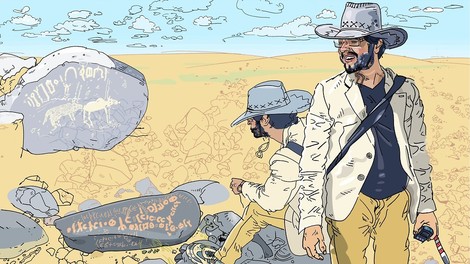Your podcast discovery platform
Curious minds select the most fascinating podcasts from around the world. Discover hand-piqd audio recommendations on your favorite topics.

piqer for: Globalization and politics Global finds Climate and Environment
Javier is a Berlin-based multimedia journalist. He completed a MA in International Journalism at City, University of London and is focused on humanitarian and conflict issues.
With experience in several countries, he's covered the refugee crisis, Turkey's coup attempt and the Kurdish conflict.
Among others, his work has been published at ABC News, Al Jazeera, Channel NewsAsia, RBB, IRIN News, El Confidencial, Público or Diario ABC.
The Stones Challenging Academic Consensus On The Origins Of The Arabic Language
Arabia before the birth of Islam remains an enigma. We don't know much about the nomad tribal society in which Prophet Muhammad was born. And neither do we know much about the early days of Islam. For decades, academics had being relying on sources composed centuries after Muhammad’s death.
That's starting to change thanks to thousands of stones in the deserts of eastern Jordan.
As Elias Muhanna reports, Ahmad Al-Jallad – one of the world’s foremost authorities on early Arabic – is making astonishing findings from Safaitic inscriptions carved into them.
Safaitic is a Semitic language that was spoken by nomad tribes of today's southern Syria and northern Jordan. Its scripts don't look at all like Arabic characters, but when you read it out it does sound very similar to the language of the Quran.
As new stones with Safaitic inscriptions are discovered, the language's database grows and makes it possible to find out more on how those nomad tribes lived. The findings are changing academic consensus on the early Islamic days.
Traditional Muslim theology, along with much Western scholarship, regards the birth of Islam as a radical break with Arabia’s past. To Al-Jallad, however, the inscriptional evidence, containing many references to peoples, events, and places that appear in the Quran and other early Islamic narratives, suggests the opposite: an evolution of Arabian ideas and practices. “This kind of society would have been very similar to the first audience of the Quran,” Al-Jallad said. “The inscriptions tell us what their world was like.”
Of course, these ideas will not be welcomed by many, especially in the countries of the Arabian Peninsula, where the idea is widely established in people's mind that southern Arabia was the cradle of the first Arabs.
However, Al-Jallad believes the Arabic language – the strongest symbol of Arab identity – may have actually developed in places like Syria and Jordan, and then migrated south.
Stay up to date – with a newsletter from your channel on Global finds.

thanks for this piq! it's been a pleasure to read the story.